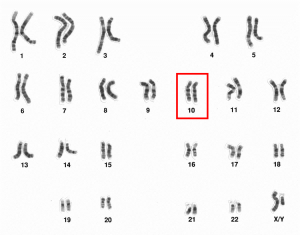I’m the IL23R gene. I’m in charge of creating the interleukin 23 receptor protein. It’s located in multiple immune system cells’ cytomembranes, including T cells, natural killer cells, monocytes and dendritic cells. The cytomembranes analyze external entities and protect the body from contamination and affliction. At the cell’s exterior, the interleukin 23 receptor protein collaborates with the interleukin 23 protein. It’s a cytokine that manages the immune system cells’ action. When the two proteins join, the interleukin 23 protein stimulates a chemical indication array in the cell. The chemical indications boost inflammation and aid in managing the immune system’s reaction to external attackers including bacteria and viruses.
My host Neil is diagnosed with Crohn’s Disease. The hereditary alteration is also known as Colitis. Crohn’s Disease is an constant disease that primarily affects Neil’s digestive system. His ileum and colon are affected, causing his intestines’ inflammation. Although his ileum and colon are primarily affected, Crohn’s Disease can affect any component of his digestive system. His inflamed tissue becomes dense and his intestines’ interior can form abscesses.

There’s an increased possibility of someone developing Crohn’s Disease if they’re Caucasian (like Neil) and in their late teenage years to twenties, however it’s possible to be diagnosed with the hereditary alteration at any moment in your life. Symptoms usually appear at multiple moments in a lifetime. The most frequent symptoms include constant diarrhea, gastric aching and cramping, reduced hunger and weight, clogged intestines and fever. Constant bleeding is a less frequent symptom caused by inflamed intestine tissue. It can cause a reduced number of anemia with time.
Alterations in me, the ATG16L1, IRGM, and NOD2 genes are linked with Crohn’s Disease.
Multiple alterations in me increase Crohn’s Disease’s possibility. For instance, Arg381Gln, a defending component for ankylosing spondylitis, also reduces Crohn’s Disease’s possibility. It’s unknown how this alteration protects the body from Crohn’s Disease, however there’s research that the receptor’s role in provoking the intestines’ exterior inflammation could form its link with the hereditary alteration.
The ATG16L1, IRGM and NOD2 genes give directions to create the autophagy related 16-like 1 protein. It’s a protein group component that is essential for the procedure also known as autophagy. It’s used by cells to convert depleted cell components and decompose particular proteins once they are not necessary. It also plays an important role in apoptosis. Autophagy is also a component in the human’s inflammatory reaction and aids the immune system in destroying a few damaging bacteria and virus forms.
The IRGM gene aids in the autophagy stimulation in particular cells contaminated with microbacteria, including the bacteria form that causes tuberculosis.
The NOD2 gene gives directions to create a protein that’s a substantial immune system performance component. It’s active in some immune system cell forms of including monocytes, macrophages and dendritic cells, that help protect the body from external intruders including viruses and bacteria. It’s also active in multiple epithelial cell forms including Paneth cells, located in the intestines’ lining. They aid in protecting the intestines’ exterior from bacterial contamination. It has multiple crucial functions in protecting the human from external intruders. It’s concerned in analyzing particular bacteria and stimulating the immune system to react accurately. When stimulated by particular entities created by bacteria, the NOD2 protein stimulates nuclear factor-kappa-B. It manages multiple genes’ action, including genes that are in charge of immune and inflammatory reactions. An inflammatory reaction occurs when the immune system sends warning molecules and white blood cells to the damaged or afflicted area to attack microbial intruders and ease tissue restoration.
Minimum one alteration in the ATG16L1 gene is linked with Crohn’s Disease’s increased possibility, principally an illness form that affects the ileum. The analyzed ATG16L1 alteration alters amino acid in a crucial area of the autophagy related 16-like 1 protein. The alteration replaces the amino acid threonine with the amino acid alanine at protein position 300. The alterations’ impacts in the ATG16L1 gene on Crohn’s Disease’s possibility are unknown. It’s alterations can affect autophagy, letting depleted cell components and damaging bacteria to continue when they would usually be destroyed. The cell components and bacteria can stimulate an improper immune system reaction, causing chronic inflammation in the intestines’ exterior.
Multiple alterations in the IRGM gene are linked with Crohn’s Disease’s increased possibility. They alter nucleotides in DNA areas that can manage when and how the IRGM protein is created. Alterations concerning the protein can disrupt autophagy, keeping the immune system from destroying damaging bacteria efficiently. An unusual immune reaction to bacteria in the intestines’ exterior can create constant inflammation.
Around forty alterations in the NOD2 gene are linked with Crohn’s Disease’s increased possibility. They’re principally linked with a disease form that affects the ileum. The most frequent alteration, known as 3020insC or 1007fs, causes the NOD2 protein to be somewhat smaller than usual. Other frequent alterations alter individual amino acids in the protein. It’s unknown how they increase Crohn’s Disease’s possibility. Alterations in the NOD2 gene keep the protein from analyzing bacteria, letting the microbes grow unrestrained and attack the cells along the intestines. An uncommon immune reaction to the bacteria can boost chronic inflammation and digestive issues.
There are hereditary alterations in chromosome 5 and 10 areas that could be linked to Crohn’s Disease’s possibility. The IBD₅ locus, a chromosome 5 area, has multiple hereditary alterations that can increase Crohn’s Disease’s possibility. Other chromosome 5 and 10 areas linked with its possibility are known as “gene deserts” as they have no identified genes.
Chromosome 5 (male)

Chromosome 10 (male)
Crohn’s Disease’s heredity is unknown as multiple hereditary and environmental components are included. The hereditary alteration can be located multiple times in families and having a contaminated family member increases its possibility. Another aspect that increases its possibility is smoking cigarettes.
Sources
